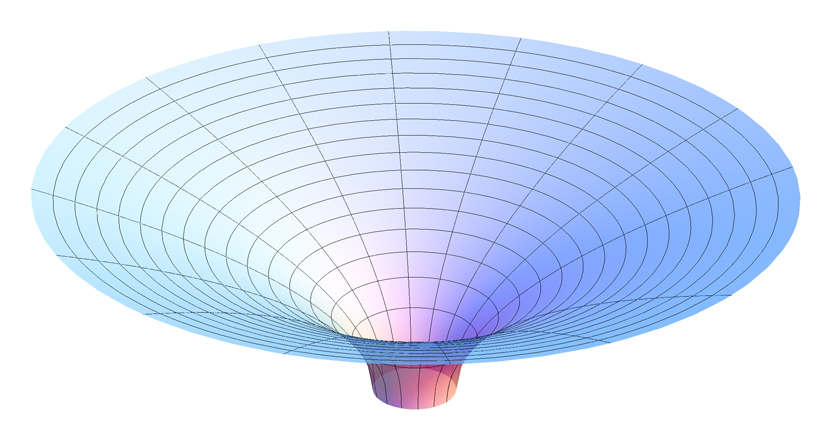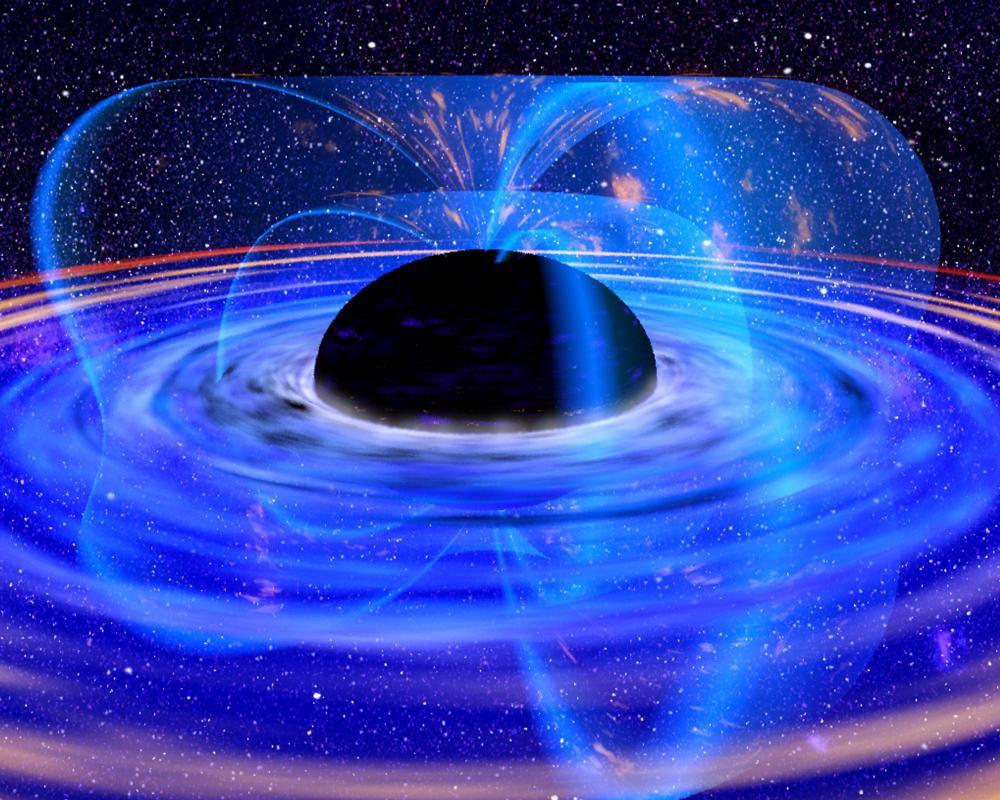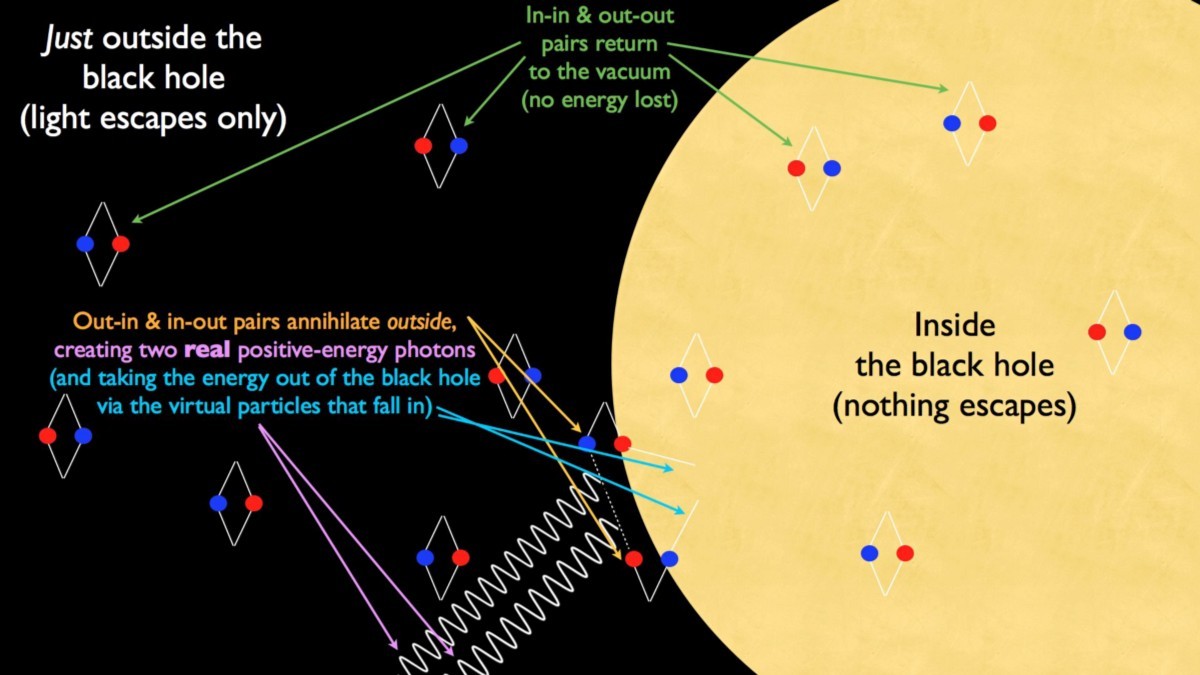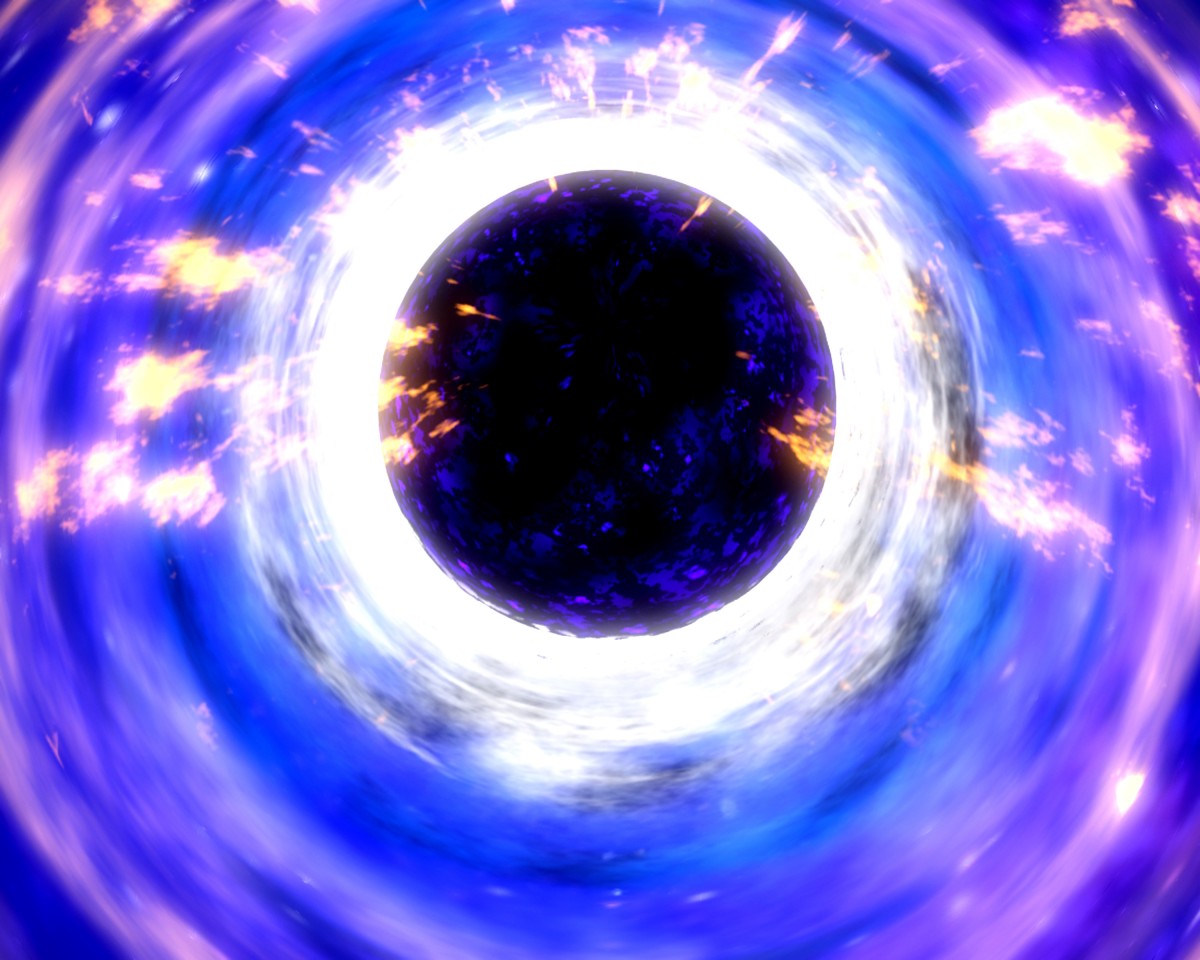Ask Ethan: How do black holes actually evaporate?
Perhaps the greatest discovery of Stephen Hawking, and the reason why he is so famous among physicists, was that black holes do not live forever.

They radiate their energy over extremely long time intervals through a process opened in 1974 and known as Hawking radiation. This week one of the readers asked the following question:
')
Since the discovery of Hawking radiation in scientific publications, it has been described as the gradual evaporation of black holes due to the spontaneous occurrence of entangled particles near the event horizon. It is said that one particle is sucked into the BH, and the other flies away and becomes Hawking radiation. Because of this, BH radiation gradually loses mass, and as a result completely disappears. The question is, if one particle falls in the black hole and the second flies away, why does the black hole become smaller? Shouldn't it, on the contrary, gain mass?
The big question contains a few misconceptions, some of which arose through the fault of Hawking himself. Let's figure it out!

More than 101 years ago, the very first exact solution of the General Theory of Relativity was found: space-time, describing a massive singularity surrounded by a horizon of events. The discovery was made by Karl Schwarzschild, who immediately realized that he described the BH: an object so dense and massive that even light cannot escape from its gravitational pull.
For a long time it was believed that if enough mass was gathered together, stuffing it into a sufficiently small region of space, the gravitational collapse to the BH state would be irreversible, and that regardless of the initial configuration of the mass, the singularity would be a point, and the event horizon would be a sphere. The only parameter of interest to scientists - the size of the event horizon - should be determined only by the BH mass.

With the absorption of BH of more and more matter, its mass increases, and it increases in size. For a long time it was believed that this would continue until there was no matter to absorb, or until the end of the universe.
But something has changed this provision. The revolutionary discovery that our Universe consists of tiny indivisible particles obeying their own set of laws, the quantum set. The particles interact with each other through various fundamental interactions, each of which can be represented as a set of quantum fields.

Want to know how two electrically charged particles interact, or how photons interact? All this is controlled by quantum electrodynamics, or the quantum theory of electromagnetic interactions. What about particles that are responsible for strong interactions: for the force that holds protons and other particles in the nuclei together? This is quantum chromodynamics, or quantum theory of strong interactions. What about radioactive decay? This is the quantum theory of weak nuclear interactions.
But this set lacks two components. One is easy to see: in the quantum world, gravitational interaction is not taken into account, since we do not have a quantum theory of gravity. And the second is more complicated: the three mentioned quantum theories usually work in a flat space, where gravitational interactions can be neglected. The space-time corresponding to this in GRT is called the Minkowski space. But near the black hole, space is bent and transformed into Schwarzschild space.

And what happens to these quantum fields not in empty and flat space, but in curved space near the BH? Hawking took up this problem in 1974 by demonstrating that the presence of these fields in a curved space near the BH leads to the appearance of thermal radiation from a black body at a certain temperature. This temperature and flow are lower, the more massive the BH, due to the fact that the curvature of space is less on the event horizon of a larger and more massive BH.
In the popular science book, A Brief History of Time (still in the first places on Amazon in the sections cosmology and relativistic physics), Stephen Hawking describes a vacuum of space consisting of pairs of virtual particles / antiparticles that arise and disappear. According to him, next to the BH, sometimes one of the two components of this virtual pair falls beyond the event horizon, while the other remains outside. At such a moment, as he writes, the external member of the couple runs away with real, positive energy, and the internal member has negative energy, due to which the BH mass decreases, which leads to its gradual evaporation.

Naturally, this picture is wrong. To begin with, the radiation emanates not only from the edge of the horizon of BH events, but from the whole of its surrounding space. But the biggest mistake in the perception of this process is that the BH actually emits photons, not particles and antiparticles. In fact, radiation has such a low energy that it is generally not capable of producing particle / antiparticle pairs.
I tried to improve the explanation of what was happening, emphasizing that we are talking about virtual particles, that is, about the way of visualization of quantum fields in nature; these are not real particles. But these properties can lead, and lead to the appearance of real radiation.

But this is not entirely true. This explanation implies that radiation near the event horizon will be strong, and will appear weak and low-temperature only at a large distance from the BH. In fact, the radiation is small everywhere, and only a small percentage of radiation can be associated with the event horizon itself.
The real explanation is much more complicated, and shows that this primitive picture has its limitations. The root of the problems is that different observers get different pictures of what is happening and the perception of particles, and this problem is more complex in a curved space than in a flat one. Simply put, one observer will see empty space, but another, moving rapidly, will see particles in it. The essence of Hawking radiation is continuously related to where the observer is and what he sees, depending on whether he is moving or resting at an accelerated speed.

Creating a BH on the place where it was not, you accelerate particles outside the event horizon, which eventually end up inside this horizon. This process is the source of this radiation, and Hawking’s calculations show how incredibly long this evaporation process is stretched over time. A BH of one solar evaporation will take 10 67 years. It will take 10,100 years for the largest BH in the Universe with a mass of 10 billion solar. At the same time, the age of today's universe is only about 10 10 years, and the evaporation rate is so small that it will take another 10 to 20 years before BHs begin to evaporate faster than they grow due to random collisions with interstellar protons, neutrons or electrons.
Therefore, responding briefly to the reader's question, we can say that the picture painted by Hawking is overly simplified to such an extent that it becomes wrong. A longer answer - to the appearance of radiation leads to a fall in BH matter, and because of the extremely curved space around the event horizon, this radiation is emitted so slowly, on such long periods of time and in such large volumes of space. For even longer and more technical explanations, I recommend referring to (on increasing complexity) the texts of Sabine Hossenfelder, John Baez and Steve Giddings.

They radiate their energy over extremely long time intervals through a process opened in 1974 and known as Hawking radiation. This week one of the readers asked the following question:
')
Since the discovery of Hawking radiation in scientific publications, it has been described as the gradual evaporation of black holes due to the spontaneous occurrence of entangled particles near the event horizon. It is said that one particle is sucked into the BH, and the other flies away and becomes Hawking radiation. Because of this, BH radiation gradually loses mass, and as a result completely disappears. The question is, if one particle falls in the black hole and the second flies away, why does the black hole become smaller? Shouldn't it, on the contrary, gain mass?
The big question contains a few misconceptions, some of which arose through the fault of Hawking himself. Let's figure it out!

More than 101 years ago, the very first exact solution of the General Theory of Relativity was found: space-time, describing a massive singularity surrounded by a horizon of events. The discovery was made by Karl Schwarzschild, who immediately realized that he described the BH: an object so dense and massive that even light cannot escape from its gravitational pull.
For a long time it was believed that if enough mass was gathered together, stuffing it into a sufficiently small region of space, the gravitational collapse to the BH state would be irreversible, and that regardless of the initial configuration of the mass, the singularity would be a point, and the event horizon would be a sphere. The only parameter of interest to scientists - the size of the event horizon - should be determined only by the BH mass.

With the absorption of BH of more and more matter, its mass increases, and it increases in size. For a long time it was believed that this would continue until there was no matter to absorb, or until the end of the universe.
But something has changed this provision. The revolutionary discovery that our Universe consists of tiny indivisible particles obeying their own set of laws, the quantum set. The particles interact with each other through various fundamental interactions, each of which can be represented as a set of quantum fields.

Want to know how two electrically charged particles interact, or how photons interact? All this is controlled by quantum electrodynamics, or the quantum theory of electromagnetic interactions. What about particles that are responsible for strong interactions: for the force that holds protons and other particles in the nuclei together? This is quantum chromodynamics, or quantum theory of strong interactions. What about radioactive decay? This is the quantum theory of weak nuclear interactions.
But this set lacks two components. One is easy to see: in the quantum world, gravitational interaction is not taken into account, since we do not have a quantum theory of gravity. And the second is more complicated: the three mentioned quantum theories usually work in a flat space, where gravitational interactions can be neglected. The space-time corresponding to this in GRT is called the Minkowski space. But near the black hole, space is bent and transformed into Schwarzschild space.

And what happens to these quantum fields not in empty and flat space, but in curved space near the BH? Hawking took up this problem in 1974 by demonstrating that the presence of these fields in a curved space near the BH leads to the appearance of thermal radiation from a black body at a certain temperature. This temperature and flow are lower, the more massive the BH, due to the fact that the curvature of space is less on the event horizon of a larger and more massive BH.
In the popular science book, A Brief History of Time (still in the first places on Amazon in the sections cosmology and relativistic physics), Stephen Hawking describes a vacuum of space consisting of pairs of virtual particles / antiparticles that arise and disappear. According to him, next to the BH, sometimes one of the two components of this virtual pair falls beyond the event horizon, while the other remains outside. At such a moment, as he writes, the external member of the couple runs away with real, positive energy, and the internal member has negative energy, due to which the BH mass decreases, which leads to its gradual evaporation.

Naturally, this picture is wrong. To begin with, the radiation emanates not only from the edge of the horizon of BH events, but from the whole of its surrounding space. But the biggest mistake in the perception of this process is that the BH actually emits photons, not particles and antiparticles. In fact, radiation has such a low energy that it is generally not capable of producing particle / antiparticle pairs.
I tried to improve the explanation of what was happening, emphasizing that we are talking about virtual particles, that is, about the way of visualization of quantum fields in nature; these are not real particles. But these properties can lead, and lead to the appearance of real radiation.

But this is not entirely true. This explanation implies that radiation near the event horizon will be strong, and will appear weak and low-temperature only at a large distance from the BH. In fact, the radiation is small everywhere, and only a small percentage of radiation can be associated with the event horizon itself.
The real explanation is much more complicated, and shows that this primitive picture has its limitations. The root of the problems is that different observers get different pictures of what is happening and the perception of particles, and this problem is more complex in a curved space than in a flat one. Simply put, one observer will see empty space, but another, moving rapidly, will see particles in it. The essence of Hawking radiation is continuously related to where the observer is and what he sees, depending on whether he is moving or resting at an accelerated speed.

Creating a BH on the place where it was not, you accelerate particles outside the event horizon, which eventually end up inside this horizon. This process is the source of this radiation, and Hawking’s calculations show how incredibly long this evaporation process is stretched over time. A BH of one solar evaporation will take 10 67 years. It will take 10,100 years for the largest BH in the Universe with a mass of 10 billion solar. At the same time, the age of today's universe is only about 10 10 years, and the evaporation rate is so small that it will take another 10 to 20 years before BHs begin to evaporate faster than they grow due to random collisions with interstellar protons, neutrons or electrons.
Therefore, responding briefly to the reader's question, we can say that the picture painted by Hawking is overly simplified to such an extent that it becomes wrong. A longer answer - to the appearance of radiation leads to a fall in BH matter, and because of the extremely curved space around the event horizon, this radiation is emitted so slowly, on such long periods of time and in such large volumes of space. For even longer and more technical explanations, I recommend referring to (on increasing complexity) the texts of Sabine Hossenfelder, John Baez and Steve Giddings.
Source: https://habr.com/ru/post/400705/
All Articles